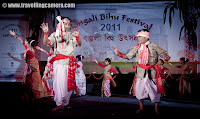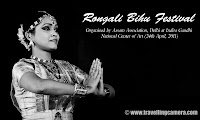Rongali Bihu Festival 2011 by Assam Association, Delhi @ Indira Gandhi National Center of Arts, New Delhi, INDIA
'Assam Association, Delhi' celebrated Rongali Bihu Festival on 24th April 2011 at Indira Gandhi National Center of Arts (IGNCA) on Ranjendra Prasaad Road near Central Secretariat Metro Station in Delhi !! This event took place during the lovely evening on Sunday in the presence of a huge audience in traditional getups. The attendance was large by Delhi standards and I am totally fan of Assamese Culture !!! Check out these Photographs from RONGALI BIHU FESTIVAL 2011 ....
On Sunday morning I was chatting with one of my friend on Facbook and she told me about this event !! Although it was a lazy Sunday for me but I thought of not missing this opportunity to get out of the house and feel the heat of Delhi :) I also took two office friends along and had a great evening !! This event continued till 11:00 pm but we had to leave early. That was a sad part for us, as no one of us wanted to leave the place...
Bohag Bihu is the national festival of Assamese as it marks the beginning of the New Year (Nava Varsha !!!). Rituals and customary practices of Bohag Bihu starts from April 13 of year. There are three forms of a Bihu festival namely Bohag Bihu or Rongali Bihu (in the middle of April), Magh Bihu or Bhogali Bihu (middle of January) and Kaati Bihu or Kongali Bihu (in October/ November).
To start the program, a group of Assam association came and sang a beautiful song in their local language... It seems that song they sung was very significant and has good impact on Assamese culture !!!
Rongali Bihu (Bohag Bihu) is the most important day of all the three Bihu festivals. This day begins with the sowing of seeds, Kaati Bihu marks the complete process of sowing and transplanting of paddies, and the Magh Bihu marks the end of the harvesting period.
Here is the lady who managed the stage with another gentleman !!! I really loved the dress-up of all the men and women their... beautiful Saaris and kurtas !! No words to explain the uniqueness and the impressions of strong culture !!!
It's just the beginning ! I was hoping some hip-hop :) ... But whole evening was packed with various versions of Bihu Dance performances... I was asked to wait till the end for actual and the BIG Bihu performance, but I had no option :(
The Bihu dance is a folk dance from the Indian state of Assam related to the festival of Bihu. This joyous dance is performed by both young men and women and is characterized by brisk dance steps and rapid hand movement. Dancers wear traditionally colorful Assamese clothing and this adds more value to overall performance !!!
Huchori - Huchori is an integral part of Rongali Bihu. Choral parties of singers and dancers moving from house to house is a salient feature of Rongali Bihu !!!
A group of boys performed Hichuri on the stage and it was really interesting to see overall getup of folks in the groups and it seems elder folks also join this group to better guide the younger ones :) .. Although I was not able to make any sense out of the songs or dialogs, but it looked very interesting !!!
The word Bihu is derived from the language of the Dimasa Kacharis... Their supreme god is Brai Shibrai or Father Shibrai. The First crops of the season are offered to Brai Shibrai while wishing for peace and prosperity. So Bi means "to ask" and Shu means "peace and prosperity" in the world. Hence the word BISHU gradually became Bihu to accommodate linguistic preferences. In Assam, Rongali Bihu is celebrated with greatenthusiasm. Celebrations begin in the middle of April and generally continue for a month !!!
An Engineer from ONGC was performing on a musical instrument and I forgot the actual name of this instrument. It was a phenomenal performance and other folks with other musical instrument made the performance best !!! It was music only performance without any song or dance...
Chief Guest Shri Tarun Chandra Gogoi, Hon'ble Chief Minister of Assam came in after few performances and his wife also wanted to witness the masti of Rogali Bihu in Delhi !!! I liked the way he entered into the main area where all the performances were going on and the way he was cheering the performers !!! He also shared some notes with the audience in Assamese which I would not understand.
Then Sattriya Dance performances continued after that and all of these were full of expressions and it seems these songs were telling some story which dancer was enacting through her steps !!!
Sattriya Nritya is one among eight principal classical Indian dance traditions. Whereas some of the other traditions have been revived in the recent past, Sattriya has remained a living tradition since its creation by the Assamese Vaishnav saint Srimanta Sankardeva, in 15th century AssamSankardeva created Sattriya Nritya as an accompaniment to the Ankiya Naat (a form of Assamese one-act plays devised by him), which were usually performed in the sattras, as Assam's monasteries are called. As the tradition developed and grew within the sattras, the dance form came to be called Sattriya Nritya.
Sattriya Nritya is one among eight principal classical Indian dance traditions. Whereas some of the other traditions have been revived in the recent past, Sattriya has remained a living tradition since its creation by the Assamese Vaishnav saint Srimanta Sankardeva, in 15th century AssamSankardeva created Sattriya Nritya as an accompaniment to the Ankiya Naat (a form of Assamese one-act plays devised by him), which were usually performed in the sattras, as Assam's monasteries are called. As the tradition developed and grew within the sattras, the dance form came to be called Sattriya Nritya.
My Favorite Performer of the evening... A cute gol-matl boy :)
His expression and steps were simply amazing !!! He was performing as lead dancer of the group and honestly, he was shining on the stage among all !!!
Here is whole team of Golu-Ram performing on Bihu Songs !!!
Sweet kids of assam performing dance on Bihu Songs during Rogali Bihu Festival @ IGNCA, New Delhi, INDIA
Lighting of the ceremonial lamp by the Hon'ble guests happening in between when Mr. Tarun Gogoi entered and they were presented with an Assamese cloth.. I don't know the exact name but it is used to put on shoulders !!!
A Wonderful Bihu Dance performance by a Assamese Girl in Mekhela Sadar !!! Mekhela Sadar was looking beautiful in wonderful expressions of the dancers on Bihu Music in the background !!!
Traditionally muga(special silk of assam) is used to make mekhela - sadar (equivalent of Saree in Assam) for girls and kurtas for boys. Till date it is considered to be the most sophisticated attire in Assam.
Muga silk is one of the many natural gift to Assam. The speciality of this silk is that it has golden bright color. "Muga" is derived from the Assamese word 'muga' meaning yellowish. It is superior in every respect from the normal white silk available all over the world. This silk is much more durable than the normal one. And interestingly it's brightness improves with evry wash while the normal silk has to be very carefully washed. Apart from normal dressings, it is used in other furnishing and decoration stuff too. Muga clothes are so durable that it can be used for decades. Muga Silk is supposed to be one of the costliest fabrics in the whole world.
Here is a photographs of main entrance for the ground where Rangoli Festival was happening... And don't ask me about Photographers.. There were lot of photographers to cover this event !!!
It was Wonderful Experience of RONGALI BIHU FESTIVAL @ IGNCA !!! I will never miss Bihu now onwards !!!
You may Also like :-









.jpg)
Comments
@ Deepak - I didn't know this !
And Deepak, I didn't know this as well. You would have known a lot of this beforehand...
Thanks for these details !!!
The photographs posted by you are so vivid that it has recreated the sweet memories of the bygone event.
I am the engineer from ONGC in one of your photograph and you have captured me playing folk music on a Hawaiin Guitar.
Bhaskar De
de_bhaskar_1@yahoo.co.in
Its really good to know that you liked this Photo story !!! and I loved your performance !
I have some of your photographs and will send on your email id by tomorrow. Please feel free to remind me at VJ@travellingcamera.com if don't get them :)
Really happy that you liked the photographs ! I hope you have checked separate story on performance by kids.
I can send you high-res photographs if you want ! Just let me know which ones you need.
+ VJ
I will get it corrected... Do you exactly remember the name of this dance form?
Few more photographs from your performance are available at http://phototravelings.blogspot.com/2011/07/semi-classical-performance-on-pulok.html